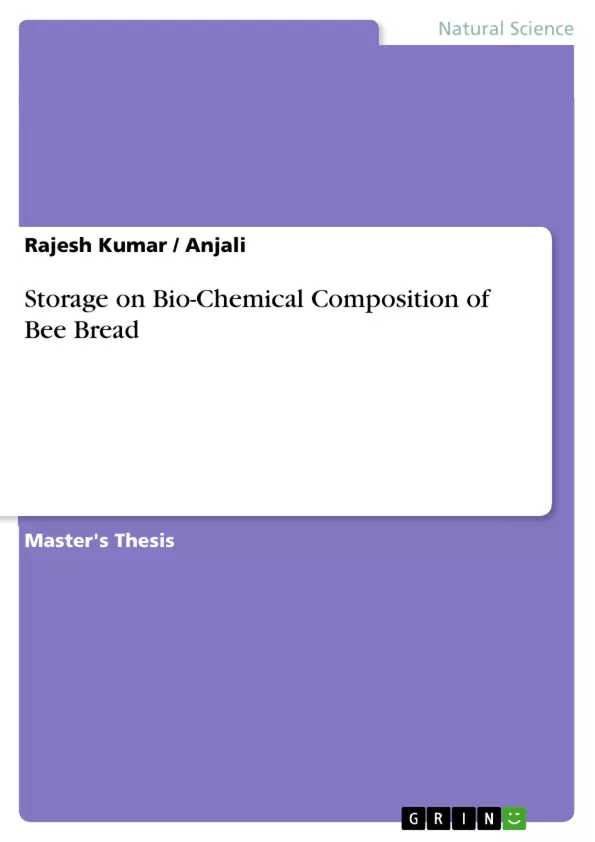Honey bees are one of the most beneficial creatures in the animal kingdom. They derive pollen and nectar from a large number of plant species for their food. The present study was carried out by using bee bread sample collected from Arni University, Indora (Kangra), during 2017-2018. In this study, two types of bee bread samples i.e. stored bee bread and fresh bee bread was used. For the biochemical analysis parameters like pH, electrical conductivity (EC), Moisture content, Ash content, Protein content, Carbohydrate content were measured. It was concluded that the end of the study that electrical conductivity and moisture content increase in stored bee bread as compare to Fresh bee bread. But in the case of Ash content, protein And Carbohydrate content reported being higher in fresh bee bread as compared to stored bee bread. The reason behind this might be the effect of time on the storage of bee bread as well as poor storage condition which lead to the degradation of biochemical component of bee bread.
Inhaltsverzeichnis (Table of Contents)
- ABSTRACT
- INTRODUCTION
- REVIEW OF LITERATURE
- MATERIALS AND METHODS
- Collection & Preservation of bee bread
- Physical appearance of bee bread
- Biochemical analysis
- pH
- Electrical Conductivity
- Moisture Content
- Ash Content
- Protein Content
- Carbohydrate content: Reducing Sugar (IS method)
- Total Sugar
- RESULTS
- DUSCUSSION
- BIBLIOGRAPHY
Zielsetzung und Themenschwerpunkte (Objectives and Key Themes)
This project aims to investigate the effect of storage on the biochemical composition of bee bread collected from Apis mellifera colonies in the Indora region of Himachal Pradesh. This study is crucial for understanding the nutritional value of bee bread and its potential for bee colony health.
- Biochemical composition of bee bread
- Effect of storage on bee bread quality
- Nutritional value of bee bread for honeybee colonies
- Potential for bee bread as a food source
- Impact of storage conditions on bee bread quality
Zusammenfassung der Kapitel (Chapter Summaries)
- Introduction: This chapter introduces the concept of bee bread, its importance for bee colonies, and the rationale for studying its biochemical composition and the impact of storage on its nutritional value.
- Review of Literature: This chapter provides a comprehensive overview of previous research on bee bread, focusing on its biochemical composition, nutritional value, and the effects of storage on its properties.
- Materials and Methods: This chapter outlines the methodology employed for collecting, preserving, and analyzing bee bread samples. It describes the specific methods used for determining the biochemical composition of bee bread, including pH, electrical conductivity, moisture content, ash content, protein content, and carbohydrate content.
- Results: This chapter presents the findings of the biochemical analysis of bee bread samples, including data on the various parameters measured. It highlights key trends and observations related to the effects of storage on the biochemical composition of bee bread.
Schlüsselwörter (Keywords)
This project focuses on the key concepts of bee bread, its biochemical composition, the impact of storage on its nutritional value, Apis mellifera, and the Indora region of Himachal Pradesh. The research explores the nutritional value of bee bread for honeybee colonies and investigates the effects of storage conditions on bee bread quality.
- Arbeit zitieren
- Rajesh Kumar (Autor:in), Anjali (Autor:in), 2019, Storage on Bio-Chemical Composition of Bee Bread, München, GRIN Verlag, https://www.grin.com/document/494530



